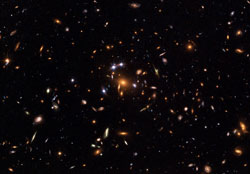Hubble captures a ‘five-star’ rated gravitational lens

This NASA/ESA Hubble Space Telescope image is the first-ever picture of a distant quasar lensed into five images. The group of five quasar images produced in a process called gravitational lensing, in which the gravitational field of a massive object - in this case, a cluster of galaxies - bends and amplifies light from an object - in this case, a quasar – farther behind it.
The NASA/ESA Hubble Space Telescope has captured the first-ever picture of a distant quasar lensed into five images. In addition the image holds a treasure of lensed galaxies and even a supernova.
The most unique feature in a new image taken with the NASA/ESA Hubble Space Telescope is a group of five quasar images produced by a process called gravitational lensing, in which the gravitational field of a massive object – in this case, a cluster of galaxies – bends and amplifies light from an object – in this case, a quasar – farther behind it.
Although other multiply lensed quasars have been seen before this newly observed “quintuple quasar” is the only case so far in which multiple quasar images are produced by an entire galaxy cluster acting as a gravitational lens.
The background quasar is the brilliant core of a galaxy. It is powered by a black hole, which is devouring gas and dust and creating a gusher of light in the process. When the quasar’s light passes through the gravity field of the galaxy cluster that lies between us and the quasar, the light is bent by the space-warping gravity field in such a way that five separate images of the object are produced surrounding the cluster’s centre. The fifth quasar image is embedded to the right of the core of the central galaxy in the cluster. The cluster also creates a cobweb of images of other distant galaxies gravitationally lensed into arcs.
The galaxy cluster creating the lens is known as SDSS J1004+4112 and was discovered as part of the Sloan Digital Sky Survey. It is one of the more distant clusters known (seven billion light-years, redshift z=0.68), and is seen when the Universe was half its present age.
Gravitational lensing occurs for extremely concentrated masses like the cores of galaxies or galaxy clusters. Their strong gravity warps the surrounding space, and light travelling through that warped space bends its direction. Multiple images of a distant light source may be seen, each taking a different path through the warped space.
A gravitational lens will always produce an odd number of lensed images, but one image is usually very weak and embedded deep within the light of the lensing object itself. Hubble’s sharp vision and the high magnification of this gravitational lens combine to place the fifth image far enough from the core of the central imaging galaxy to make it visible.
The galaxy hosting the background quasar is at a distance of 10 billion light years (at redshift 1.74). The quasar host galaxy can be seen in the image as faint red arcs. This is the most highly magnified quasar host galaxy ever seen.
The Hubble picture also shows a large number of stretched arcs that are more distant galaxies lying behind the cluster, each of which is split into multiple distorted images. The most distant galaxy identified and confirmed so far is 12 billion light years away (a redshift of 3.33, corresponding to only 1.8 billion years after the Big Bang).
By comparing this image to a picture of the cluster obtained with Hubble a year earlier, the researchers discovered a rare event – a supernova exploding in one of the cluster galaxies. This supernova exploded seven billion years ago, and the data, together with other supernova observations, are being used to try to reconstruct how the Universe was enriched by heavy elements through these explosions.
Media Contact
More Information:
http://www.spacetelescope.org/news/html/heic0606.htmlAll latest news from the category: Physics and Astronomy
This area deals with the fundamental laws and building blocks of nature and how they interact, the properties and the behavior of matter, and research into space and time and their structures.
innovations-report provides in-depth reports and articles on subjects such as astrophysics, laser technologies, nuclear, quantum, particle and solid-state physics, nanotechnologies, planetary research and findings (Mars, Venus) and developments related to the Hubble Telescope.
Newest articles

Recovering phosphorus from sewage sludge ash
Chemical and heat treatment of sewage sludge can recover phosphorus in a process that could help address the problem of diminishing supplies of phosphorus ores. Valuable supplies of phosphorus could…

Efficient, sustainable and cost-effective hybrid energy storage system for modern power grids
EU project HyFlow: Over three years of research, the consortium of the EU project HyFlow has successfully developed a highly efficient, sustainable, and cost-effective hybrid energy storage system (HESS) that…

After 25 years, researchers uncover genetic cause of rare neurological disease
Some families call it a trial of faith. Others just call it a curse. The progressive neurological disease known as spinocerebellar ataxia 4 (SCA4) is a rare condition, but its…





















